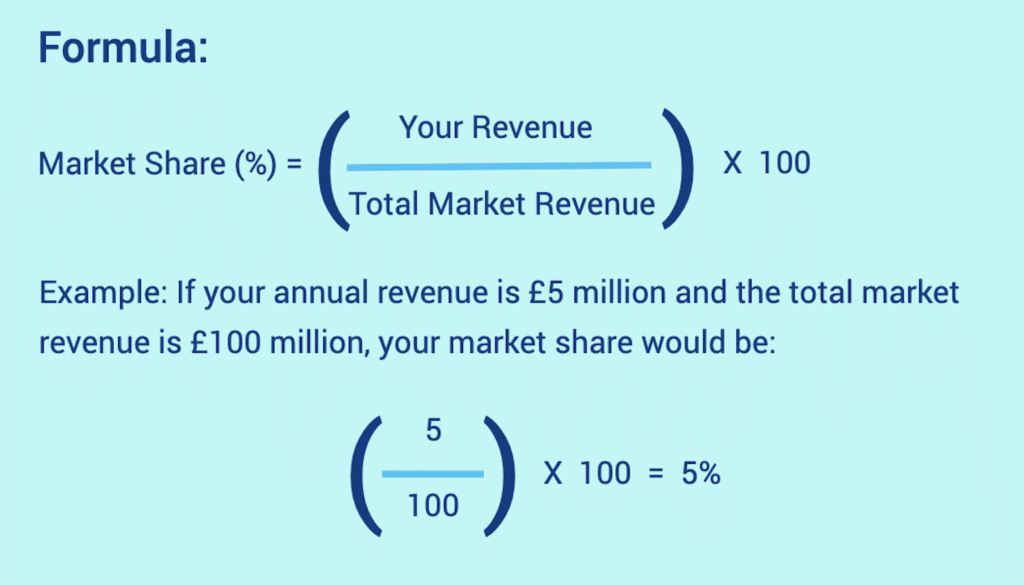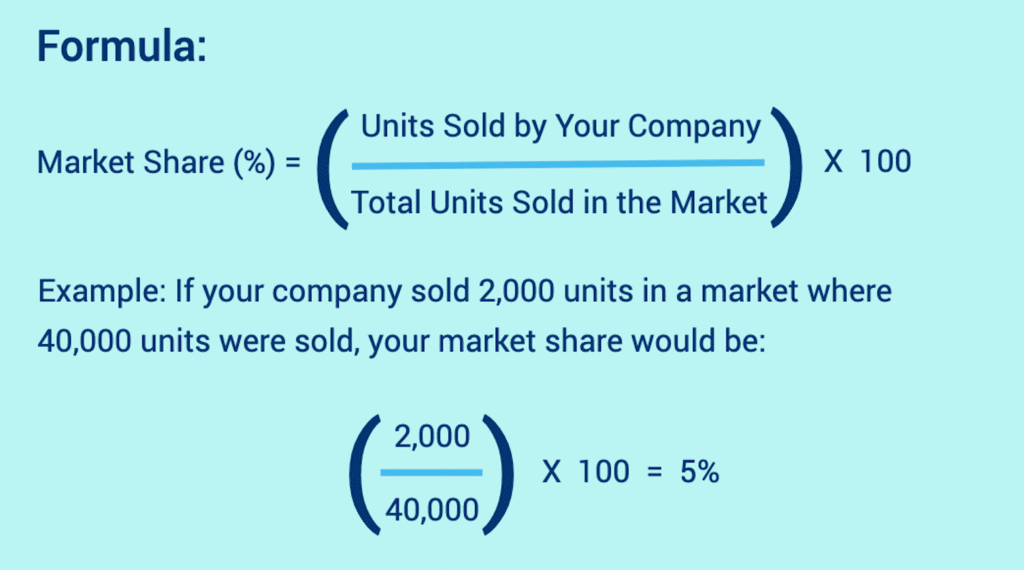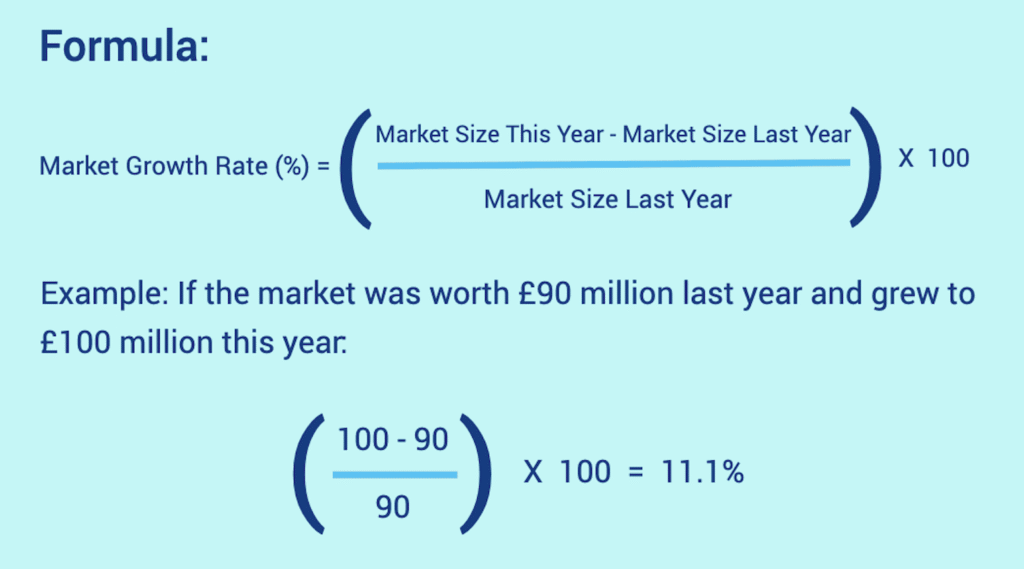What is Market Share?…
Market share provides a snapshot of your startup’s performance within the industry. It is the percentage of an industry’s total sales revenue or volume that your company captures. For a B2B tech startup, this metric reflects the market share your product or service controls compared to competitors. By understanding your market share, you can assess your competitive position and opportunities for growth.

Why Tech Startups Care About Market Share
Calculating this metric helps you understand, in more quantifiable terms, how well your business is performing. This may massage a founder’s ego, but what it should really be used for is to track growth trends and measure the effectiveness of your go-to-market strategy. With a clear picture of market share, you can identify gaps where a solution might gain more traction, improve your competitive advantage and ultimately guide you to focus on areas that yield the highest returns.
Build a Picture of Your Performance
Market share analysis is useful because it supports your strategic planning and resource allocation, so your efforts can be better directed toward high-potential segments. When operating in a hyper competitive category, where customer acquisition can be costly and time-intensive, knowing your share of the market helps prioritise opportunities and demonstrates your growth potential to stakeholders and potential investors. Understanding market share is a critical step for any B2B tech startup aiming to refine strategy, attract funding and accelerate growth.
Here’s your guide to calculating market share and using the insights effectively.
How to Calculate Market Share
There are two primary ways to calculate market share: by revenue or by units sold.
1. Market Share by Revenue

2. Market Share by Units Sold

Other Key Metrics to Track
Beyond market share alone, there are other metrics you can combine with it to provide a fuller picture of your position and potential. Here are a few additional metrics to consider:
1. Market Growth Rate
This metric shows how quickly your target market is expanding, helping you assess whether you’re positioned in a growing or stagnant industry.

2. Customer Penetration Rate
This metric reflects the percentage of potential customers in your target market who are using your product.

3. Churn Rate
A high churn rate (customers leaving) can limit your ability to grow market share. Monitor this closely to identify retention issues.

Using Market Share Insights to Refine Strategy
Once you’ve calculated your market share and related metrics, you can use the insights to enhance your business strategy.
- Identify gaps in the market where competitors are underperforming. For instance, if your competitors are struggling with customer support, highlight your excellence in this area to gain market share.
- Investors want to see evidence of market traction and potential. A clear analysis of your market share, growth trends and competitive advantages can make a compelling case for funding.
- A strong market position can be a magnet for top talent. Share your growth metrics in recruitment materials to demonstrate your company’s stability and potential.
- Use market share insights to shape your messaging. For instance, if you dominate a specific niche, emphasise your leadership in that area to build brand equity.
- Companies with strong market positions are attractive to potential partners. Highlighting your market penetration and growth trajectory can help secure alliances that further enhance your competitive edge.
Presenting Market Share to Stakeholders
When presenting market share to stakeholders, clarity and context are key. Use these tips to ensure your data makes an impact:
- Use bar charts, pie charts and growth trend lines to make the information digestible. Highlight comparisons between your company and key competitors.
- Explain what your market share means in practical terms. For example, “Our 5% market share represents £5 million in annual revenue, positioning us as a leader in the SMB segment.”
- Share data on how your market share has grown over specific periods. This demonstrates momentum and helps build confidence in your strategy.
- Don’t just present numbers, explain what they mean for the future of your company. For instance, identify areas where you can grow your share or improve customer retention.
Key Messaging and Indicators
When sharing your findings, emphasise the following:
- Highlight how your growth strategy is designed for long-term success.
- Showcase what sets you apart, whether it’s pricing, technology or customer support.
- Indicate how you plan to increase your market share as the company grows.
When to Start Measuring Market Share
The best time to start measuring market share is as soon as your B2B tech startup begins generating consistent sales and engaging with your target market. Early tracking provides valuable benchmarks to monitor growth, assess the competition and refine your go-to-market strategy. Key individuals who should be involved include the CEO or founder, who can align market share insights with overall strategy, the marketing team, to assess branding and lead generation performance, the sales team, to track customer acquisition and penetration and financial analysts, who can tie market share to revenue forecasting and investor reports. Collaboration across these functions ensures a comprehensive approach to understanding and leveraging market share.
Measure Regularly in a Consistent Way
Keep the process as standardised as possible so that regular reporting is consistent. This analysis can be completed at least once a year as a minimum, or as frequently as every quarter or month, to align with business reporting cycles. The appropriate frequency may depend on how big and dynamic your market is and the pace of your growth. Calculating market share is more than just crunching numbers for the sake of it because it allows you to gain a deeper understanding of your startup’s current position and future potential. This knowledge is invaluable for shaping growth strategies and communicating effectively with stakeholders. By combining market share with other key metrics and presenting it strategically, you can refine your approach and build a compelling narrative that resonates with investors, employees and partners alike.
You may want to read: “How to Define Your Target Market.”







